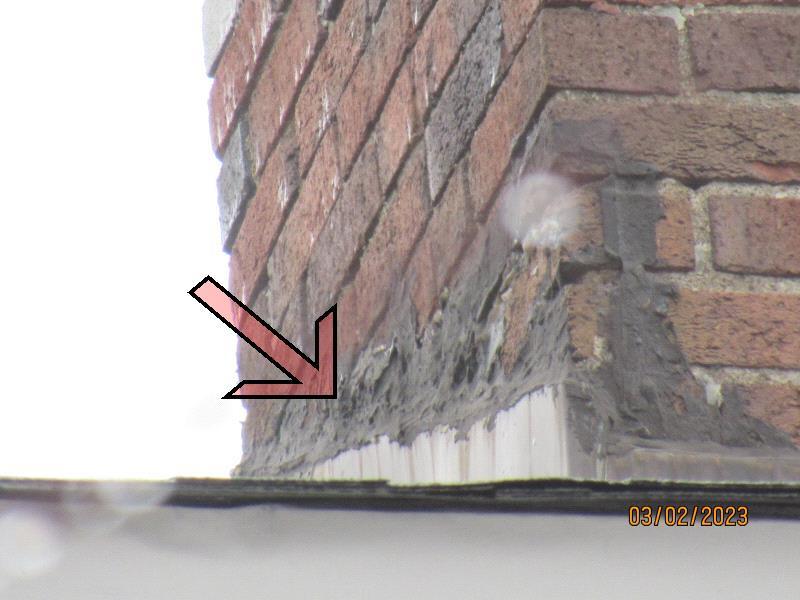New Jersey home inspectors should be looking for improperly installed or missing chimney flashing details. The chimney flashing is the set of sheet metal details that keeps the area between the chimney and the roof watertight. Chimney flashing is often poorly installed or missing altogether. Without a good reliable chimney flashing water will enter around the chimney which can cause the roof decking to become water damaged. Water can also follow the chimney down to the second and first floor of the home causing damage along the way. Mold growth can also occur due to the moisture entry around the chimney.
I found while performing home inspections in NJ that most of the chimney flashings are poorly installed. They are either missing important details, are too small, and in some cases not complete. It is up to the NJ home inspector to inspect the flashings and determine if they are deficient. A deficient chimney flashing is often a flashing that leaks.
Chimney flashing can be made of several different metal materials. The most prevalent is aluminum. Aluminum is a popular chimney flashing material because it is inexpensive and rust resistant. Steel can also be used however it is vulnerable to rusting. Copper flashings are sometimes used but they are considerably more expensive. Copper is a great flashing material that does not rust, it is very lightweight and very durable. The most prevalent chimney flashing material found in NJ is aluminum.
A properly configured chimney flashing has several components that work together to create a watertight seal around the chimney. Apron flashing is a flashing detail that is installed at the front of the chimney under the roof shingles. The apron flashing is the first flashing detail to be installed when properly installing all flashing details. The apron flashing protects the front of the chimney from water entering where the chimney comes up through the roof surface.
Step flashing is a bent piece of rectangular flashing that is used to seal the chimney roof intersection on the left and the right sides of the chimney. Multiple pieces of this flashing will be installed in a step like pattern along the sides of the chimney. The steps flashing will be covered with roofing shingles at its base and then covered with a counter flashing from above. The step flashing is not secured or fastened to the chimney, it is installed with a slight gap to allow the natural expansion and contraction of the roof decking materials. If the flashing were to be installed flush and tight to the chimney it would pull away with the contraction of the roof deck.
A pan flashing is a flashing detail that is installed at the back side of the chimney. The top pan flashing protects the top of the chimney where it protrudes the roof surface.
The flashing that is most problematic and often missing is the counterflashing. The counterflashing is the flashing detail that is installed on both the left and the right side of the chimney that is cut into the chimney. Its purpose is to cover the step flashing by making a watertight seal around the chimney. Often what will happen is the step flashing is improperly installed and cut into the chimney and the counter flashing is missing entirely. NJ home inspectors should be on the lookout for missing counter flashing and report is as a deficiency.
When a chimney is greater than 30 inches wide a chimney cricket should be installed to divert water from the back side of the chimney. A cricket is a triangular roofing and flashing detail that is designed to direct water from the rear portion of the chimneys. Without a cricket water, snow and ice will lay against the rear of the chimney making it vulnerable to water entry. A cricket is useful at protecting the rear of the roof and the chimney from this water collection and thus water penetration. New Jersey home inspectors should report on missing chimney cricket details if the chimney is wider than 30 inches and there is no cricket installed.
Home inspectors should also inspect the area around the chimney as seen from the attic space of the home. Often, we will find water stains and water damaged roof decking in this area. A moisture meter should be used to confirm active moisture. Sometimes stains are old. It is useful to test them with a moisture meter especially if it has rained recently. Any water penetration viewed around the chimney as seen from the attic should be reported on. The likely cause of these water stains is an improperly flashed chimney.
Home inspectors should also report on the excessive use of roofing tar or roofing cement around the base of a chimney. If there is a properly installed flashing, there is no need to slather roofing tar all over the base of the chimney. Roofing cement will get brittle over time and fail. Roofing cement use around the chimney is a deficiency although many of the homes in NJ will have excessive use of this tar.
Chimney flashings are very important in keeping water out from the area around the chimney penetration through the room. Home inspectors in NJ should be familiar with the proper installation of chimney flashing details and report on any deficiencies. Deficiencies in chimney flashings can create vulnerabilities which can lead to water entry, damage, and mold growth.

